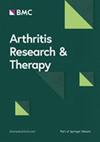IL-23 在实验性关节炎疼痛和疾病中的作用模式
IF 4.9
2区 医学
Q1 Medicine
引用次数: 0
摘要
我们以前曾利用基因缺陷小鼠报道过,白细胞介素(IL)-23p19 亚基是先天性免疫驱动的关节炎疼痛和疾病发展所必需的。我们的目的是在此使用多种体内方法探索 IL-23p19 亚基如何以一种独立于 T 淋巴细胞和 B 淋巴细胞的方式从机制上控制关节炎疼痛和疾病。我们在野生型和Il23p19-/-小鼠中使用了zymosan诱导的关节炎(ZIA)模型,通过辐射嵌合体方法以及单细胞RNAseq和qPCR分析,确定了发炎关节中表达IL23p19和IL-23反应的细胞类型。该模型还被用来研究用中和单克隆抗体(mAb)阻断IL-23p19亚基的疗效。建立了一种新型 IL-23 驱动的关节炎模型,从而确定了 IL-23 在控制疼痛和疾病方面的推定下游介质。疼痛和关节炎分别通过相对静态重量分布和组织学进行评估。我们提出的证据表明:(i) ZIA 疼痛和疾病的发生需要 IL-23p19+ 非骨髓来源的巨噬细胞;(ii) IL-23p19 亚基的预防性和治疗性阻断可改善 ZIA 疼痛和疾病;(iii) 系统给药 IL-23 可诱发关节炎疼痛和疾病,其方式依赖于 TNF、GM-CSF、CCL17 和环氧化酶活性,但独立于淋巴细胞、CGRP、NGF 和 P 物质。所提供的数据将有助于 IL-23 靶向治疗炎症性疾病和临床试验的设计。本文章由计算机程序翻译,如有差异,请以英文原文为准。
The mode of action of IL-23 in experimental inflammatory arthritic pain and disease
We have previously reported using gene-deficient mice that the interleukin (IL)-23p19 subunit is required for the development of innate immune-driven arthritic pain and disease. We aimed to explore here, using a number of in vivo approaches, how the IL-23p19 subunit can mechanistically control arthritic pain and disease in a T- and B- lymphocyte-independent manner. We used the zymosan-induced arthritis (ZIA) model in wild-type and Il23p19−/− mice, by a radiation chimera approach, and by single cell RNAseq and qPCR analyses, to identify the IL23p19-expressing and IL-23-responding cell type(s) in the inflamed joints. This model was also utilized to investigate the efficacy of IL-23p19 subunit blockade with a neutralizing monoclonal antibody (mAb). A novel IL-23-driven arthritis model was established, allowing the identification of putative downstream mediators of IL-23 in the control of pain and disease. Pain and arthritis were assessed by relative static weight distribution and histology, respectively. We present evidence that (i) IL-23p19+ non-bone marrow-derived macrophages are required for the development of ZIA pain and disease, (ii) prophylactic and therapeutic blockade of the IL-23p19 subunit ameliorate ZIA pain and disease and (iii) systemically administered IL-23 can induce arthritic pain and disease in a manner dependent on TNF, GM-CSF, CCL17 and cyclooxygenase activity, but independently of lymphocytes, CGRP, NGF and substance P. The data presented should aid IL-23 targeting both in the choice of inflammatory disease to be treated and the design of clinical trials.
求助全文
通过发布文献求助,成功后即可免费获取论文全文。
去求助
来源期刊

Arthritis Research & Therapy
RHEUMATOLOGY-
CiteScore
8.60
自引率
2.00%
发文量
261
审稿时长
14 weeks
期刊介绍:
Established in 1999, Arthritis Research and Therapy is an international, open access, peer-reviewed journal, publishing original articles in the area of musculoskeletal research and therapy as well as, reviews, commentaries and reports. A major focus of the journal is on the immunologic processes leading to inflammation, damage and repair as they relate to autoimmune rheumatic and musculoskeletal conditions, and which inform the translation of this knowledge into advances in clinical care. Original basic, translational and clinical research is considered for publication along with results of early and late phase therapeutic trials, especially as they pertain to the underpinning science that informs clinical observations in interventional studies.
 求助内容:
求助内容: 应助结果提醒方式:
应助结果提醒方式:


